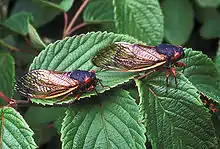Paraneoptera
Paraneoptera or Acercaria[1] is a monophyletic superorder of insects which includes four orders, the bark lice, true lice, thrips, and hemipterans, the true bugs.[2]
| Paraneoptera | |
|---|---|
 | |
| Magicicada septendecim, a cicada (Hemiptera) | |
| Scientific classification | |
| Kingdom: | Animalia |
| Phylum: | Arthropoda |
| Class: | Insecta |
| (unranked): | Eumetabola |
| (unranked): | Paraneoptera |
| Orders | |
| |
All of the insects classified here exhibit various “reductions” or “simplifications” from the primitive body-plan found in typical polyneopterans. Cerci, for example, are entirely absent in all living paraneopterans (Acercaria meaning without cerci). Other “reductions” occur in wing venation, in the number of tarsal segments (not more than three), in the number of Malpighian tubules (not more than six), and in the number of ganglia present in the ventral nerve cord (not more than five).
The mouthparts of the Paraneoptera reflect diverse feeding habits. Basal groups are microbial surface feeders, whereas more advanced groups feed on plant or animal fluids.[2]
Phylogeny
| Parametabola |
| ||||||||||||||||||||||||
Taxonomy
Hemiptera
Hemiptera /hɛˈmɪptərə/ is an order of insects most often known as the true bugs (cf. bug), comprising around 50,000–80,000 species of cicadas, aphids, planthoppers, leafhoppers, shield bugs, bed bugs and others. They range in size from 1 millimetre (0.039 in) to around 15 centimetres (5.9 in), and share a common arrangement of sucking mouthparts.
Psocoptera
Psocoptera, the bark lice, include 4,400 described species arranged in 3 suborders, Trogiomorpha, Troctomorpha, and Psocomorpha. There are 50 families of bark lice with over 200 genera. This is the first insect order to show the beginnings of a transition to sucking mouthparts. It is sister group to the Phthiraptera.
Phthiraptera
Phthiraptera, the lice, includes 5,000 described species divided into 4 suborders. The Amblycera is the most basal group and parasitize birds and mammals. The Ischnocera is the largest suborder and parasitize mostly birds and some groups of mammals. The Rhynchophthirina, the elephant lice, consists of only 3 species that parasitize elephants and wild pigs in Africa. The Anoplura (sucking lice) parasitize only mammals.
Thrips
Order Thysanoptera includes 5,500 species classified into two suborders distinguished by the ovipositor. Terebrantia have a well-developed conical ovipositor, while the Tubulifera do not. Instead the abdomen is drawn out in the shape of a tube. These insects are called thrips.
References
- Hu Li et al., Higher-level phylogeny of paraneopteran insects inferred from mitochondrial genome sequences, Hu Li Ren, fu Shao, Nan Song, Fan Song, Pei Jiang, Zhihong Li & Wanzhi Cai, Scientific Reports volume 5, Article number: 8527 (2015)
- David A. Grimaldi & Michael S. Engel (2005). "The Paraneopteran Orders". Evolution of the Insects. Volume 1 of Cambridge Evolution Series. Cambridge University Press. pp. 261–330. ISBN 978-0-521-82149-0.
